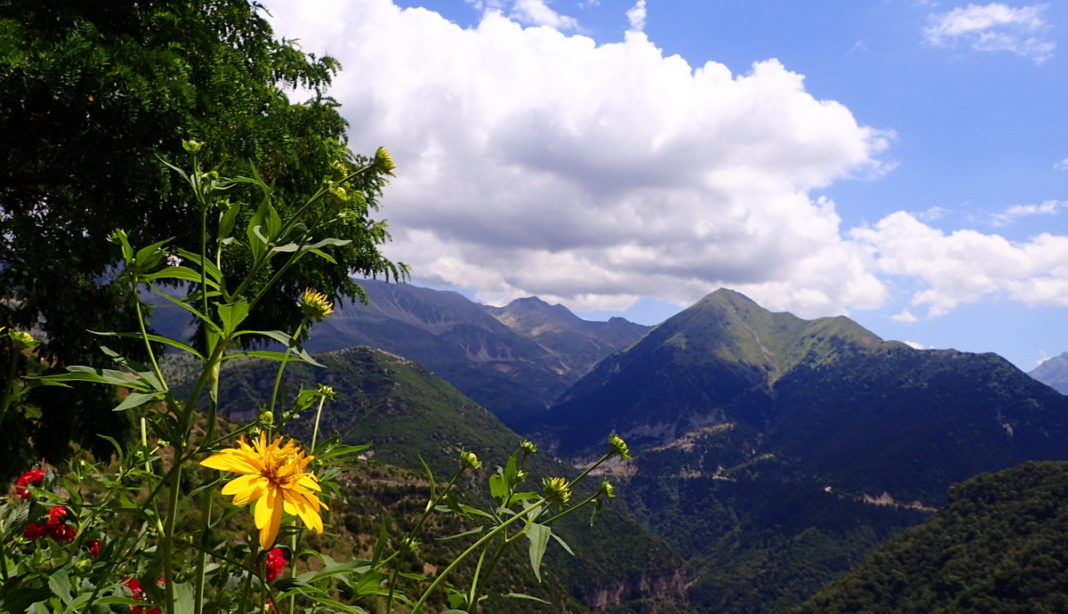Tzoumerka – or Athamanika – is one of Greece’s most exciting mountain regions. Its peak – Katafidi – is 2393 m high. In all of the surrounding mountains, there’s plenty to interest the traveler. Tzoumerka is dotted with picturesque towns, historic preserved villages, and extraordinary monasteries. The natural charms are the glorious mountains themselves, waterfalls cascading and rivers rushing below, rich wildlife as well as herds of sheep, and even a well-known cave.
To get the most out of Tzoumerka, you’ll want a sturdy vehicle to navigate the hairpin turns as the roads ascend staggering heights and reveal astonishing views. We had expert drivers acquainted with the region – Vasillis and Vasillis of Limo-Van (the best drivers in all of our travels ever). You’ll also need sturdy shoes. Many of the loveliest villages – built on steep slopes – are not accessible by car. You park outside at the edge of the village and hike in. Monasteries too require a commitment, rewarding you with a hike almost as glorious as the destination.
The drives in Tzoumerka are reason enough to visit. For more beautiful road trips, you can read about the most Beautiful Drives in Crete.
Table of Contents
The Villages of Tzoumerka
It’s a unique sense of community up here in the mountains – together, and yet separate. Neighboring villages can be a mere kilometer or two apart, facing each other across a ravine. To get from one village to the next though, there’s a long and treacherous drive of sharp turns and thrilling vistas as you descend and climb the neighboring peaks. Or, you can do as the locals have for centuries, by using the network of “kalderimia.” These are stone paths designed for hoof traffic, linking villages and fields up and down the sides of mountains. Locals navigate them with ease, often wielding a hand-carved wooden cane for stability. Even the oldest residents of Tzoumerka are agile and light on their feet. Hiking, and the reflective nature that comes with it, are part of the nature of the people of Tzoumerka.
The History of the Villages of Tzoumerka
Only the boldest people could make such a beautiful life for themselves in this uncompromising terrain. The villages of Tzoumerka are famous for their beauty. They’re known for having skillful masons, constructing stone villages that shimmer silver from a distance. They’re also excellent shepherds; the meats and cheeses of Tzoumerka are peerless, and so are their traditional woolen crafts, which once were renowned throughout the Balkans and beyond.
The Vlach Villages of Tzoumerka

The Vlachs are Greeks with Aromanian heritage. They’re historically mountain people, principally shepherds. Prominent Greeks – such as the great revolutionary Rigos Feraios, the benefactors Evangelos Zappas and Konstantinos Zappas (cousins who were instrumental in the founding of the modern Olympic Games – you’ll know their name from the Zappeion in Athens), and the statesman Evangelos Averoff – have Vlach roots. Greece’s first constitutional Prime Minister, Ioannis Kolettis, was of Aromanian origin, and born in Syrrako. Ioannis Kolettis was the statesman credited with founding the “Megali Idea” – or “Great Idea” – which became the foundation for Greek foreign relations and domestic politics into the early 2oth century. The Great Idea aspired to unify all regions historically inhabited by Greeks from ancient times into the modern Greek state.
The Vlach language descends from Latin. The Vlachs themselves are thought to be descended from Roman soldiers or of Latin speaking populations in Greece.
There are five principal Vlach villages in Tzoumerka, two of which are famously beautiful and are protected under historic preservation laws to maintain their unique character.
Pramanta

Pramanta is the main village of the Tzoumerka region. It spreads out along a mountain ridge with stunning views. This was the village of the stone masons, who built the surrounding famously lovely villages. Pramanta is easily accessible by car.
Pramanta itself has very few traditional buildings. This is because they suffered a large earthquake in the 1970s. Still, this is one of the finest villages of the region, with a classic town square under the shade of a plane tree, a beautiful church, and tavernas with excellent grilled meats.
It makes an ideal home base for touring around the Tzoumerka region. After a long day of exploring, it’s nice to have a glass of red wine around the plane tree and then drive right to your hotel, rather than hike in.
Syrrako
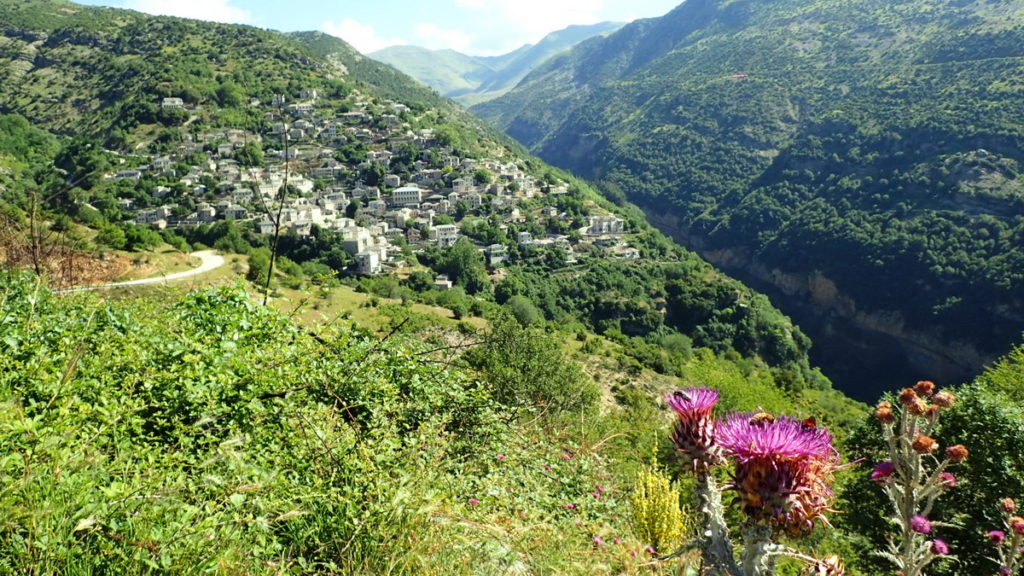
The first sight of Syrrako as you round the side of the mountain is stunning. The stone houses of this historically preserved village have traditional slate roofs that shimmer like silver in the sunlight. Syrrako is arranged beautifully on a steep hillside, surrounded by tall mountains and lush ravines.
To enter the village, you need to leave your car on lower ground outside and hike in. A stone bridge crosses a ravine with a babbling brook. Sweet water gushes constantly from a fountain. By the bridge is an old stone washery – the laundry mat of the past, where the thick and fluffy “flokati” carpets would be scrubbed white in the rushing water.
Syrrako is historically one of the most prosperous of the villages of Tzoumerka. The traditional stone buildings are beautifully crafted and quite large, with many aristocratic homes among them. The village dates from the 15th century, but owes its prosperity to a later event. The Valide Sultan – the mother of the ruling Sultan in the Ottoman Empire – wielded great power. The first woman to hold the title was Hafsa Sultan, the mother of Suleiman the Magnificent. She showed her favor upon the village of Syrrako, because it was Syrrako that maintained and oversaw the all-important local network of kalderimia, those mountain paths essential for transit and trade throughout the empire.

Icons and a beautifully carved iconostasis in Syrrako. 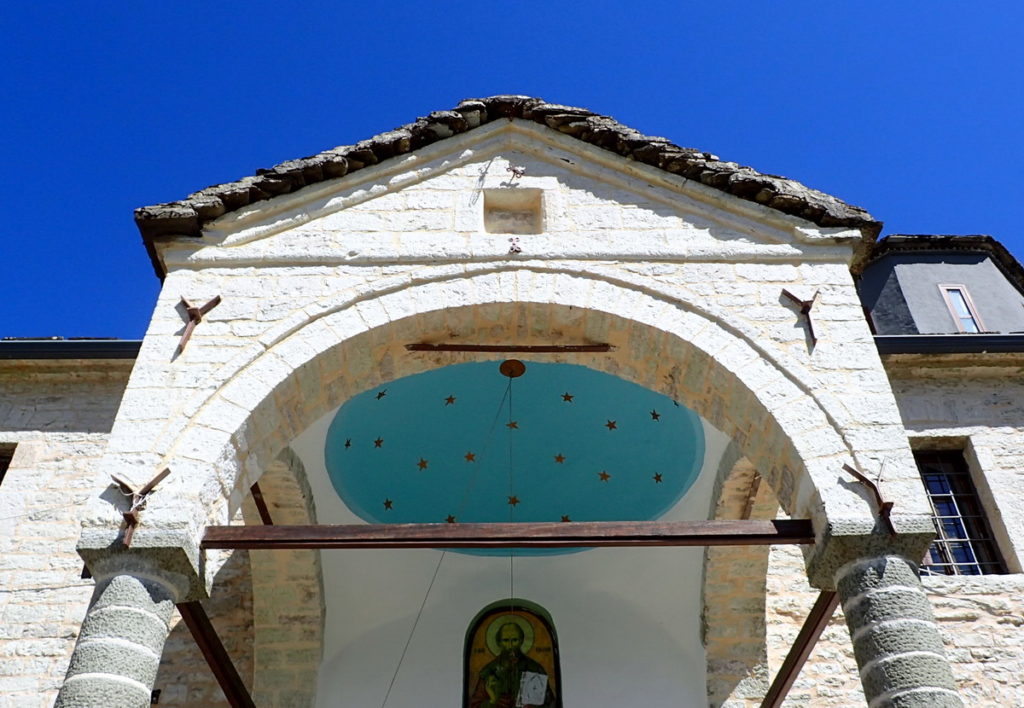
The Church of Syrrako 
The wollens of Syrrako were famous throughout the Balkans and abroad 
A fountain on the kalderimi leading to Syrrako
This meant that, in addition to their shepherding activities, the people of Syrrako also freely engaged in trade. They excelled. Because much of the population were shepherds, they had great flocks and excellent wool. The merchants of Syrrako exported their quality wool and woven goods, bringing them by mule down the kalderimia to the port of Preveza, and overseeing their export abroad.
The church has many lovely icons from the Ionian Islands. This is because some of the successful merchants of Syrrako eventually took up residence in the Ionian Islands, maintaining close ties with the village. Many became great benefactors of Syrrako.
Kalarytes
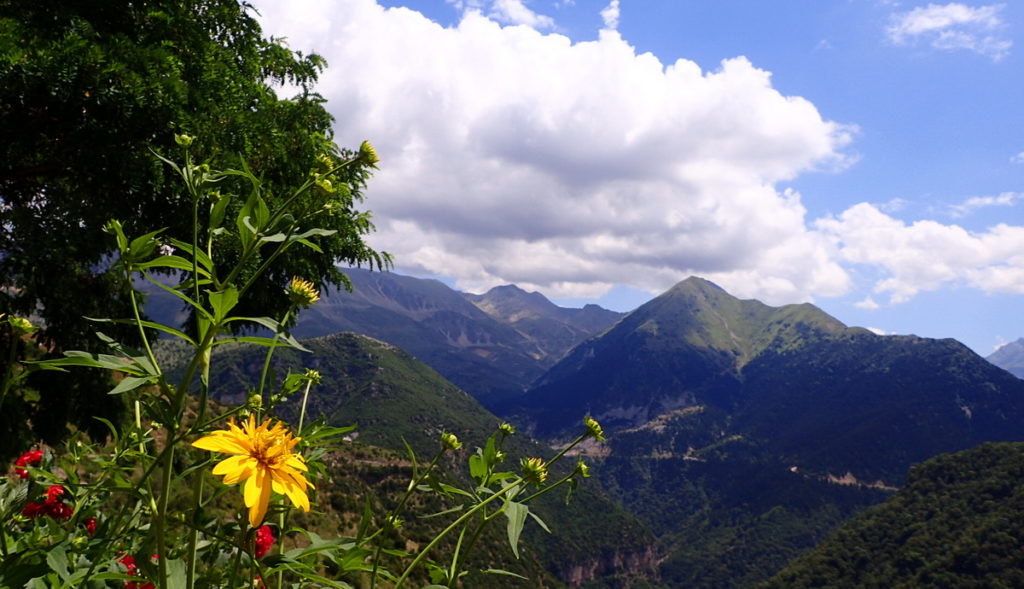
At an elevation of 1200 meters, lovely Kalarytes is sometimes called the ‘Eagles’ Nest’ of Epirus
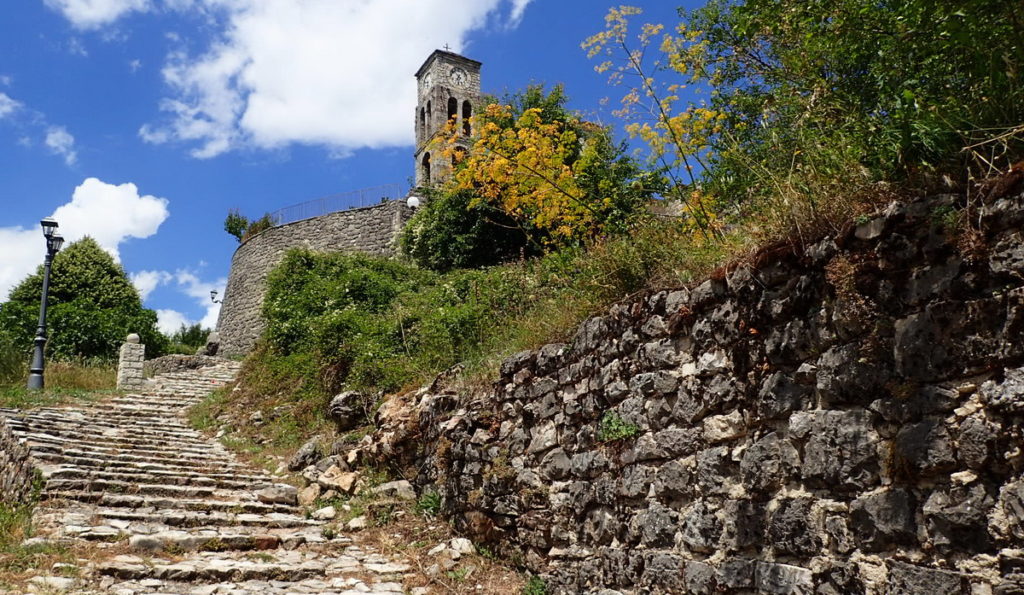
A Kalderimi connects Syrrako with Kalaryrites, another of the Vlach villages of Tzoumerka. Like Syrrako, Kalarytes too is a protected village because of its traditional stone architecture. Also like Syrrako, Kalarytes was very prosperous. But rather than specializing in stock breeding and in woolens, the people of Kalarytes were creative in a diversity of fields. They were also known for painting and hagiography (icon painting), for tailoring, for transporting goods, and – perhaps chiefly – for gold and silversmithing. The gold and silver were brought from Italy. Then the craftsmen of Kalarytes, particularly in the 18th century, created elaborate designs for both ecclesiastic and secular objects. Their fame was widespread throughout the Europe. As far north as Vienna and as far west as Marseilles, the silversmiths of Kalarytes were known for quality craftsmanship.
Of these families, one is very well-known – Voulgaris. The accomplished silversmith Sotirios Voulgaris moved from Kalarytes to Rome in the 1880s and opened a store that would become the famous brand Bulgari.

Now, the most famous resident of Kalarytes is undoubtedly Napoleon Zaglis. In addition to a running a rustic inn, this dynamic man runs the local “Pantopoleio” – literally, a shop that sells everything. In a small village like this, the pantopoleio is the heart of the community, where you can stop in for anything from shampoo to chocolate bars to the latest news of the village. Most of all, people come for a chat with Napoleon, the fifth generation to run the pantopoleio (open since the 19th century), and a keeper of traditions and song. Napoleon’s panotpoleio is an informal restaurant with excellent home cooking.
Natural Wonders in Tzoumerka

Crossing the Arachthos Gorge 
The Arachthos Gorge
All of Tzoumerka is gloriously beautiful – a bold landscape of peaks and deep ravines. This is a hikers’ wonderland, with a network mountain paths and kalderimia for exploring. Waterfalls cascade into gorges. There’s water everywhere – sweet and icy waters gush from springs in every village.
The National Park of Tzoumerka
The National Park of Tzoumerka covers an area of over 800 square meters. This magnificent nature preserve protects endemic species and ecosystems. In the National Park of Tzoumerka, you can encounter otters, brown bears, wild goats, and deer. Many species of birds make their homes here, as well as amphibians, reptiles, and rare butterflies.
Anemontrypa Cave, Tzoumerka
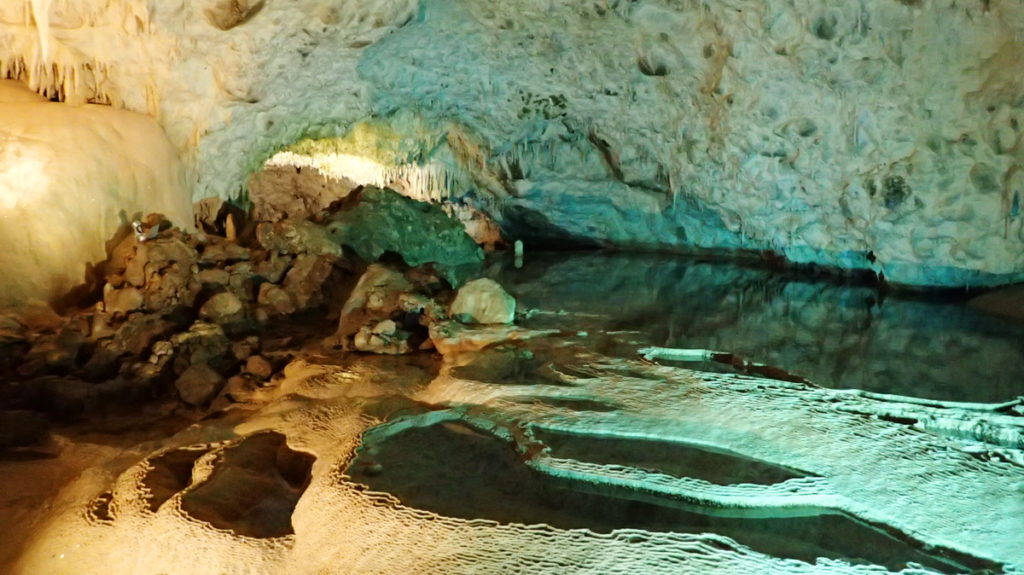
With so much beauty outside, you wouldn’t think to look inwards. However, just outside of Pramanta, signs lead us to a magical cave. Anemotrypa cave was only discovered in 1960, by cool air flowing out of an opening in the rock. This is how it got its name; anemotrya means “wind hole” (anemos = wind, trypa = hole). There’s more water here, too – you can hear the underground waterfall and a river flowing. In addition to the beautiful stalactites and stalagmites we see in most caves, there’s another beautiful formation – lacy white mineral pools, like a miniature Pamukkale.
The Monasteries of Tzoumerka
The divine scenery and uncompromising landscape of Tzoumerka are made for isolation and contemplation. We saw two beautiful monasteries during our visit.
Monastery of Viliza

Near the village of Matsouki, a paved stone path rises to scale the side of a mountain. The 2 km hike rises and falls, but mostly rises. There are plenty of stairs. Ascending to a monastery is part of the experience, a meditative preparation. The vistas are themselves evidence of a divine hand.
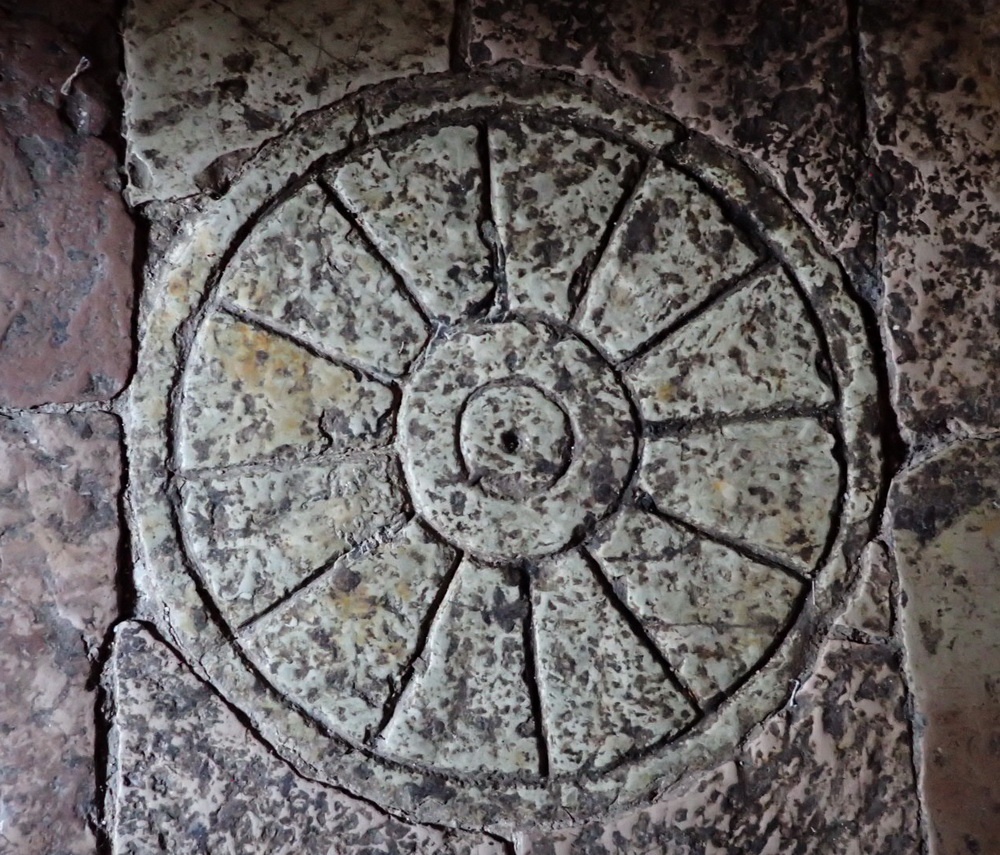
An early symbol of Christianity, in the middle of the floor of the chapel 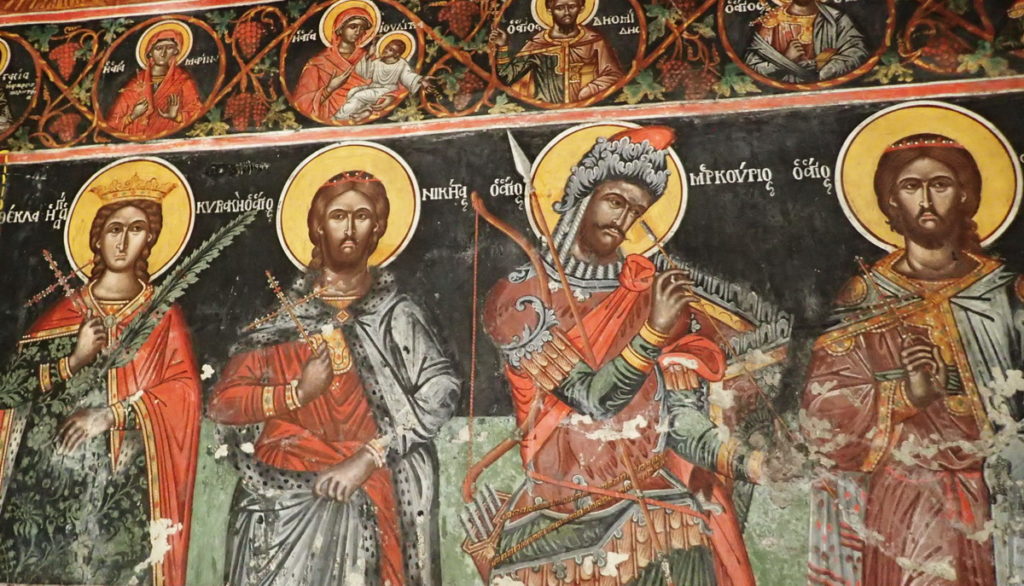
Detailed frescoes at the Chapel of St. John, Viliza Monastery 
Loukoumia and Tsipouro – a traditional Monastery welcome 
The path ascending to the Viliza Monastery
On arriving, glowing from the hike, the priest welcomed us with glasses of cold water, “loukoumia” (sweet soft confections) and tsipouro (a distilled spirit of grape marc) – traditional hospitality at a monastery. We sat together under the loggia in the stone courtyard and he told us about the long history of the monastery. We then visited the chapel. 11th-century frescoes in rich colors cover its walls. There is an additional smaller chapel, dedicated to St. John. One enters through a very low door, to greet the altar in a pose of humility. The wall painting here, also of the 11th century, are extraordinary in their refinement. The faces express individual character and nuanced emotion. On the floor, formed of stone, is an early symbol of Christianity, indicating that everyone around the circle belongs to the community of Christians.
The precious icons of the church are replicas. The original icons are kept safely in a museum in the neighboring village of Matsouki.
Kipinas Monastery
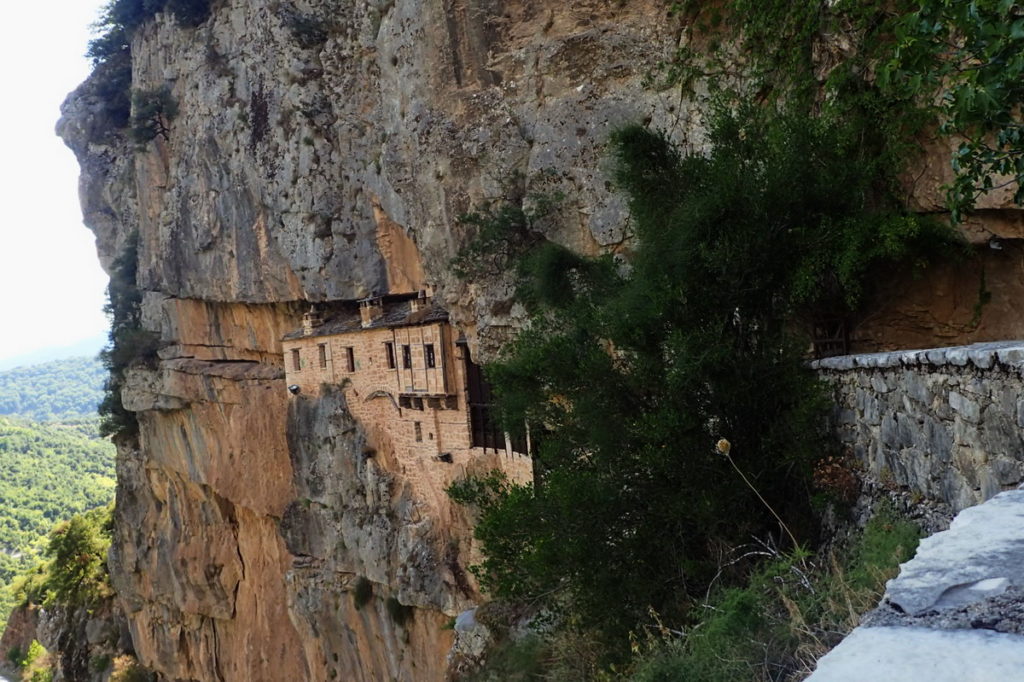
On the road to Kalarytes, you have a gorge to your right, and a steep cliff to your left. Hidden high within this cliff is the Kipinas Monastery. A short path ascends to the monastery, which has been constructed in a natural cave. There are monks’s cells, no longer inhabited, and a small chapel from the 18th century. The chapel is built off of the side of a cave. At the cave’s edge is the mouth of a treacherous cave path that leads to the other side of the mountain. Entering is dangerous and not advised. The Kipinas Monastery is often locked – one gets the keys from a keeper in the village just before the monastery.
The Famous Bridge of Plaka

Greece was liberated in three stages from the Ottoman Empire. The Modern Greek state was founded after the first phase, which was the Revolution of 1821. Macedonia, Thrace, and many islands joined Modern Greece in 1912. And there was also an intermediary phase in 1881. During this time, the Arachthos River was the border. The major crossing was the Plaka Bridge. By the bridge you’ll see the former customs house.
One of the wonders of Epirus are its great stone bridges. The bridge building masons of Epirus – called “kioproulides” – were famous for them. This high single arched bridge was rare among the many excellent examples of bridge building – a wonder of engineering. The Plaka Bridge collapsed in a flood in 2015, and has only just reopened. The bridge was rebuilt with traditional methods by teams of masons – including teams from Albania who are famous for their stone work. The work was overseen by a local master mason.

